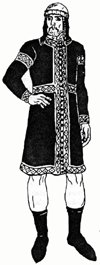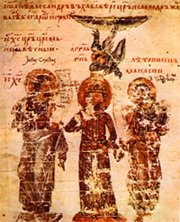Insignia and attire of the Bulgarian rulers during the period of the Second kingdom (1185-1396)
Tsar Peter IV/II 85/6-1197/ and tsar Assen I /1186-1195/6/
By close study of the written sources /mainly with those of Nicita Honiat and Teodor Scutariot/, it can be concluded that the first Bulgarian rulers of the Second Bulgarian kingdom /re-established in 1185-1186/ were not enthroned with stephanos, but with stemma. This is proven by the authentic seal of tsar Asscn I /1187-1196/, which the stemma is engraved on, complemented by a cross, propendules, a lorus, a ruler's cross and an akakia. It is refused that at the palace ceremonies Assen I /1187-1196/ and his successors used the regalia of the Byzantine emperor which was captured in the year 1190, in the Balkan mountain of Tryavna /it seems, that according to the custom the regalia was given as a gift to some of the big churches of Turnovo/. It is also refused that Peter IV /Theodor-Belgun/ is represented on an emission of billons holding the captured double emperor's cross /the billons probably were coined by Theodor Mangapha/.
Tsar Kaloyan /1197-1207/
 |
Reconstruction of the costume of the man buried in grave ¹ 39 (after V. Inkova) |
It is most likely, that the youngest brother of Peter IV and Assen I, Kaloyan was also enthroned with his brothers' ruler's regalia. Yet, as was the situation with Simeon, their tsar's titles and regalia were not sanctioned by Constantinople and Rome, because Bulgaria did not have any canonically appointed patriarch. Kaloyan was the man who acted most consistently in favour of settling this problem. When in the beginning of XIII century Byzantium got into a hard crisis, he decided, that it is much more prestigious to look for an acknowledgement, given by the Roman pope Inokentii III, with whom he began an extensive correspondence. As a result, the pope attracted Bulgaria temporarily, though only on paper, to Catholicism, and Kaloyan was proclaimed King and the king's crown, scepter and ensign were sent to him. Kaloyan however, having always insisted on getting the emperor's title and insignia, pretended deliberately to be absent-minded and thanked Inokentii III perfunctory for the emperor's title, crown and scepter. The pope pretended to be absent-minded too , and also deliberately did not reproach Kaloyan for his misunderstanding of what kind of title and insignia were given to him, thus becoming somewhat of an accomplice in the proclamation of Kaloyan as an emperor. The regalia, received from Rome, were obviously royal /a fact, that undoubtedly the Bulgarian ruler knew very well/ and because of this he deliberately did not have himself represented with them upon official documents /mainly seals and coins/. To some extent it could be judged of their mode by a depiction of a crown affixed to a graphic initial "R" in one of the letters of the pope to Kaloyan, where it was exactly notified of the insignia sent to Turnovo Structurally, it was different both from the crowns of German, Latin and Byzantine emperors from XII-XIII centuries, and from those of the West-European kings, which usually included a wreath of four lilies. Shape-wise it resembles considerably the crowns of the Latin, Jerusalem and Cyprus rulers, contemporaries of Kaloyan.
Special attention is paid to funeral ¹39 in the "St. 40 Martyrs" church in Velico Turnovo, which most of the Bulgarian historians attribute to Kaloyan, on the grounds of the discovered gold ring with the inscription: "Kaloyan s ring". Drawing on the findings of technical-laboratory analysis and the restored attire /a purple cap with a periphery and a veil, a red scaramangion with aureate bands and cuffs, red booths and trousers/, as well as on some texts by Kodin about the attire of the highly ranking dignitaries I come to the conclusion that a Bulgarian sebastocrator or despot is probably buried in grave ¹ 39. It is possible, however, that Bulgarian and the Byzantine tsars were also buried in similar purple attire. In their works Constantine VII and Kodin did not describe particularly the attire and the insignia of the buried emperors.
Tsar Boril /1207-1218/
If judged by the intact seals, he used the regalia of Assen I and Peter IV - a low crown-stemma, a ruler's cross, a lorus and an akakia. Though he did not officially terminate the union with Rome, he obviously intentionally dismissed the crown, the scepter and the ensign, given by the pope. He encountered some problems in Bulgaria regarding the legitimacy and because of this he deliberately manifested in public that he was the successor of Assen and Peter, by wearing their insignia.
Tsar Ivan Assen II /1218-1241/
Ivan Assen II made a real breakthrough in the entitling of the autocrator and the regalia of the ruler of the Second Bulgarian kingdom, whereat he repeated, and to some extent surpassed the achievements of Simeon the Great. Judging by the early coins, he initially wore the insignia ofAssen I - the stemma, the lorus and the akakia. After a series of victories and with the assistance of the Byzantine emperor himself, the eastern patriarchs proclaimed Bulgarian emperor at the council in Lampasque /1235/, /something which neither Simeon achieved, nor even tsar Saint Petre I with such success/, whereby the tsar's title of Assen II was juridically legitimated. Similar to Simeon, with great self-assertiveness he made an unwarranted step higher up in the hierarchical scale of the Christian rulers, as he proclaimed himself emperor of the Byzantines. In accordance with this title he introduced some new autocrator's regalia /a semispherical crown-kalelaukion, a labarum and a sphere, with which he is depicted on a wall-painting in a rock church near the village of Ivanovo, as well as on gold coins.
Heirs apparent to tsar Ivan Assen II /between 1241 and 1277/
The achievements of Ivan Assen II consolidated unconditionally the Bulgarian tsar's /emperor's/ title, respectively the tsar's insignia - the crown-kamelaukion, the lorus, the sphere, the labarum, the ruler's cross, the akakia, the divitasion and the maniakion.
His heirs valued all this for its merits and it was not accidentally that they added to their title the name ofAssen, which legalized them as indisputable Bulgarian tsars. In this sense there could not be any doubt, that the regalia of Ivan Assen II had no rivalries in the cases, when between the middle of XIII and the end of XIV century the ruler's dignity had to be manifested. This is confirmed by the most detailed portrait of a Bulgarian ruler existing in the church of Boyana. Tsar Constantine Assen /1257-1277/ is depicted in a full-length, and his crown and regalia are a replica of those, used by Ivan Assen II after the year 1235.
Insignia of the Terters /between 1280 and 1322/
Until now no any authentic portrait of the tsars of this family, ruling over Bulgaria between 1280 and 1322 is discovered. Only emissions of coins of Georgi I Terter /1280-1292/ and of Swetoslav/1299-1321/ are available. However, their depictions are too conventional and conform to the traditions of the workshops, where they were coined. A cross-encolpion, relevant to Georgi Terter II /1321-1322/ is worth noting.
Mihail-Shishman /1323-1330/
The well-intact portraits of this ruler are those on coins. A special attention deserves an earlier emission, on which, as it seems, he is engraved wearing a crown of a despot with four plates.
Tsar Ivan Alexander /1331-1371/ and his successors /between 1371 and 1422/
 |
The divine coronation of tsar Ivan Alexander according to a miniature in the chronicle of Manasius |
Ivan Alexander /1331-1371/ is the ruler of Bulgaria with the most numerous authentic depictions upon wall-paintings /in the cloister of Batchkovo, in Ivanovo, in Berende and in the church ¹14 on the hill Trapesitza in Turnovo/, 8 miniatures on the Gospel of London and on the chronicle of Manasii, 2 seals and 12 types of coins. With a few exceptions he is everywhere depicted with the same insignia, handed down from Ivan Assen II - a crown-kamelaukion, a lorus, an akakia, a ruler's cross and a divitassion. The same ornate set was also worn by his sons and successors, the last Bulgarian tsars and Ivan Shishman and Ivan Sratsimir.
|
··· HOME ···
 Regalia, attire and religious beliefs of the first Bulgarian khans
Regalia, attire and religious beliefs of the first Bulgarian khans
 Insignia and attire of the rulers of the First Bulgarian kingdom after the conversion to Christianity (864-1018)
Insignia and attire of the rulers of the First Bulgarian kingdom after the conversion to Christianity (864-1018)
 Insignia and attire of the wives of the medieval Bulgarian rulers
Insignia and attire of the wives of the medieval Bulgarian rulers
 Insignia and attire of the Bulgarian high ranking dignitaries in the Middle Ages
Insignia and attire of the Bulgarian high ranking dignitaries in the Middle Ages
 About the treasure of Preslav and the insignia and the adornments of the noblest Bulgarian aristocrats during the Middle Ages
About the treasure of Preslav and the insignia and the adornments of the noblest Bulgarian aristocrats during the Middle Ages


 Regalia, attire and religious beliefs of the first Bulgarian khans
Regalia, attire and religious beliefs of the first Bulgarian khans